Amazing Antarctica: Land of Ice and Snow
Wednesday, December 30th, 2009The short version is that Antarctica was absolutely incredible and contained the most beautiful scenery we’ve ever seen. The long version is below:
The Voyage
Our ‘Classic Antarctica’ trip took us to the South Shetland Island and then to the west side of the Antarctic Peninsula, which is conveniently the closest part of Antarctica to South America, but also one of the best places to visit in the white continent because of the many offshore islands and the channels between them and the Antarctic mainland. The Google Earth shot below shows the Peninsula and the Tierra del Fuego.
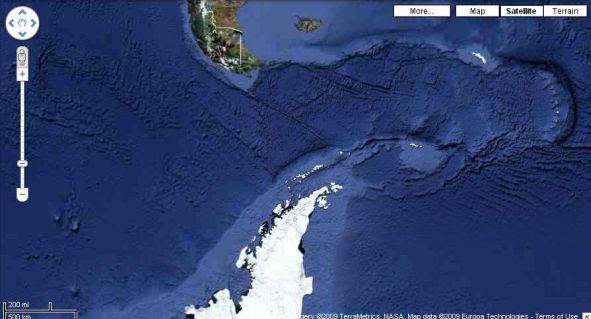
For wildlife, there are no polar bears in Antarctica (they only live in the Arctic), and we did not see Emperor Penguins (of ‘Happy Feet’ and ‘March of the Penguins’ fame), because they live in a different area of the continent. We did, however, see three different species of penguins, four different species of seals, and whales.
A day by day account follows:
Day 1: The Beagle Channel
We boarded the M/V Ushuaia, originally built in the 1960s by the U.S. for Arctic research, at about 4:30pm, and within an hour-and-a-half we had left the port, champagne in hand from the welcome party, and were navigating the calm waters of the Beagle Channel. The Ushuaia has space for 84 passengers, and its previous trip 10 days earlier was sold out, but in our case there were only 70 passengers on board. (The previous day in Ushuaia we saw a last-minute price for US$1200 per person lower than what we paid – damn! – but even that special deal wasn’t enough to fill the ship.) To everyone’s surprise, including their own, the 28 Dutch passengers made up by far the biggest national majority, while at the other end of the spectrum there were solitary travellers flying the flags of Brazil, Colombia, Italy, Northern Ireland and, surprisingly, Australia.
Even though we booked the lowest class of accommodation on board, it was still quite nice and comfortable. We had our own two-person cabin with two bunk beds as well as a desk, wardrobe and sink, with a semi-private bathroom shared with a (Dutch) couple in the next cabin.
After a late dinner (caprese salad, chicken teriyaki and chocolate brownies with ice cream – hey, I could get used to this cruise thing), we were quite tired and went to sleep at about 10pm.
Day 2: The Drake Passage
We awoke in the middle of the night to discover that the Beagle Channel was well and truly behind us, and that we were now navigating the treacherous open waters of the Drake Passage between Tierra del Fuego and Antarctica, which has been described as the roughest stretch of water on the planet. For those prone to motion sickness such as myself, the rocking of the boat (which I as a non-sailor would have described as significant) made it virtually impossible to sleep thereafter and, when morning came, moving about the boat and doing basically anything except lying down was tough for me. To rub it in, the crew kept saying how fantastic the weather was for the crossing and how calm it was and lucky we were.
Outside it was indeed a gloriously sunny day (9.5 degrees Celsius), but it was wasted in the Drake Passage where you cannot see any land. In the afternoon, by which time I had become used to the swaying of the boat and could move around comfortably, we went out on deck and watched several different types of birds fly around the boat, some with wingspans twice as long as a grown human. Having had a lecture on the birds of the Drake Passage earlier in the day, we all used our newly-minted expert status to differentiate between the different types of albatrosses and petrels.
After dinner (pasta salad, breaded beef with mashed potatoes, and strawberries and cream), we watched a documentary on the doomed early 20th century Antarctic voyage of Sir Ernest Shackleton and his men, who survived over a year-and-a-half in the Antarctic after their ship was wrecked without the loss of a single life. Then I put the missing pieces together of the story I was trying to tell some other hikers the previous week in Torres del Paine: Shackleton’s Australian photographer Frank Hurley, mentioned and quoted several times in the documentary, was the great-grandfather of my friend Flip, who is herself a kind of modern adventurer and made news last year in Australia for her (sadly aborted) walk across Greenland.
Day 3: Half-Moon Island
Because of the excellent weather conditions in the Drake Passage, we arrived at the South Shetland Islands, close to the Antarctic Peninsula, about 3-4 hours ahead of schedule which allowed for a bonus landing. (Though, entrenched as I was in the Memorias de Idhún, I missed out on the reward of a bottle of wine for the first iceberg sighting.)
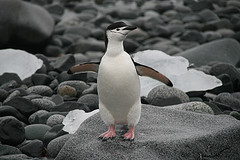 For the first time since leaving the port at Ushuaia, we dropped anchor in the cove created by the half-moon shape of the appropriately-named Half-Moon Island, and prepared to make our first landing. Unfortunately, the sun of the previous day had disappeared and it was pretty gloomy outside (3.5 degrees Celsius) – dark grey clouds blanketed the sky, lifting a few metres above the water level to reveal glimpses of glacial and snowy islands in an unusual light. But it wasn’t windy or raining, so while photographers weren’t too happy with the weather, both the ship staff and the penguins thought it was pretty good.
For the first time since leaving the port at Ushuaia, we dropped anchor in the cove created by the half-moon shape of the appropriately-named Half-Moon Island, and prepared to make our first landing. Unfortunately, the sun of the previous day had disappeared and it was pretty gloomy outside (3.5 degrees Celsius) – dark grey clouds blanketed the sky, lifting a few metres above the water level to reveal glimpses of glacial and snowy islands in an unusual light. But it wasn’t windy or raining, so while photographers weren’t too happy with the weather, both the ship staff and the penguins thought it was pretty good.
We took the zodiacs (rubber motor boats usually accommodating 8-10 passengers) to shore and disembarked, immediately seeing the first of two types of penguins on the island: the Chin-Strap penguin, so called because of a black line that extends from ear to ear underneath the chin like the strap of a helmet. Later we also saw the red-billed Gentoo penguin, and three different species of seal, including a baby that one of the staff said was the smallest he had seen in six years of doing these voyages. He added that on the Ushuaia’s previous voyage (i.e. the one we had tried to book but missed out on), they had not seen any seals on Half-Moon Island. Though we’d seen sea lions (very similar to seals) before in Peru and just a few weeks ago on the Península Valdés, it was the first time we had seen penguins in their own environment so that was quite thrilling. There were hundreds of them on the island, waddling about awkwardly as they do, and probably many more swimming offshore.
Satisfied then with our first landing, we sat down to dinner (ceviche, beef sirloin and apple compote) and then prepared for the night crossing of the Bransfield Straits, known as the mini-Drake passage.
Day 4: The Gerlache Straits
“As you can see, conditions are quite Antarctic today…” came the morning announcement over the intercom. Owing to heavy snowfall and poor visibility, we abandoned our first planned landing of the day at Hydruga Rocks and instead did a ‘cruise’ on the zodiacs (in 1.5 degrees Celsius weather!) through Gouvernøren Harbor. We saw a 1916 shipwreck but otherwise it wasn’t a great outing owing to the cold and the virtually horizontal snow fall, and we were glad to be back on the ship once it was over.
In the afternoon, we reached the Antarctic continent for the first time and began navigating alongside it, a pattern that we would follow for the next several days. We also saw humpback whales for the first time (but certainly not the last, as sightings soon became routine). Our afternoon landing at Danco Island yielded more penguins and what would have been a spectacular 360 degree viewpoint, but clouds obscured the view in all directions.
The conditions had made it a pretty disappointing day, but as we entered the Andvord Bay, where we would anchor for the evening (dinner: soup, chicken, chocolate ice cream with fritters), our moods began to improve. The mist that had hung over Antarctica for most of the day disappeared, replaced by a blanket of deep grey clouds that, while still obscuring the views beyond the shoreline, created a surreal atmosphere. Navigating through this land of ice and snow and eerie light, I felt as though we were on a completely different planet.
And, as dusk fell on Antarctica, ever so slowly the sky began to clear…
Day 5: Antarctica (Christmas Eve)
I don’t even know how to begin describing how amazing this day was, but l will try this: if every other day of the voyage offered nothing but howling winds, non-stop snow, no wildlife sightings and no views whatsoever, then the entire trip and the US$8350 it cost us would have been completely worthwhile just for this one day. It was, by far, the best single day of ‘travel’ we have ever experienced together and we saw easily the most spectacular scenery of our lives.
 Our morning landing at Neko Harbour, at the end of Andvord Bay, was our first on the Antarctic continent, and with the sun out and blue skies around us we trudged past Gentoo penguins through the snow to a lookout point offering spectacular views of the peninsula’s peaks, glaciers and green, iceberg-strewn waters. One glacier that we had been looking at from the ship since the previous evening now revealed itself to be a glacial iceberg detached from the mainland that we estimated as being 10 times the size of the Ushuaia. After the extreme cold of the day before, we were actually hot and had to take off our jackets, and more than a few people got sunburned. When we returned to the ship, it had been surrounded by small icebergs to create yet more postcard views.
Our morning landing at Neko Harbour, at the end of Andvord Bay, was our first on the Antarctic continent, and with the sun out and blue skies around us we trudged past Gentoo penguins through the snow to a lookout point offering spectacular views of the peninsula’s peaks, glaciers and green, iceberg-strewn waters. One glacier that we had been looking at from the ship since the previous evening now revealed itself to be a glacial iceberg detached from the mainland that we estimated as being 10 times the size of the Ushuaia. After the extreme cold of the day before, we were actually hot and had to take off our jackets, and more than a few people got sunburned. When we returned to the ship, it had been surrounded by small icebergs to create yet more postcard views.
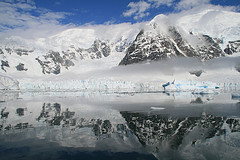 Our afternoon landing, our second and last on the continent itself, was not as glorious, but remarkably, the highlight of the day was yet to come: a zodiac cruise in Paradise Bay that was so indescribably magnificent that even ‘jaded’ travellers like ourselves were completely blown away . Icebergs, shimmering glaciers and snow-capped mountains combined to form a white wonderland that almost completely surrounded us and was brilliantly reflected in the Antarctic waters and immeasurably enhanced by the sunshine and blue sky. We approached an enormous glacier in our zodiac and sat there for about half an hour, mostly just staring open-mouthed at how incredible it all was.
Our afternoon landing, our second and last on the continent itself, was not as glorious, but remarkably, the highlight of the day was yet to come: a zodiac cruise in Paradise Bay that was so indescribably magnificent that even ‘jaded’ travellers like ourselves were completely blown away . Icebergs, shimmering glaciers and snow-capped mountains combined to form a white wonderland that almost completely surrounded us and was brilliantly reflected in the Antarctic waters and immeasurably enhanced by the sunshine and blue sky. We approached an enormous glacier in our zodiac and sat there for about half an hour, mostly just staring open-mouthed at how incredible it all was.
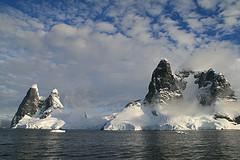 After dinner (king crab, turkey, and cake), we navigated through the stunning Lemaire Channel, no more than 150-200 metres wide at its narrowest point and with glaciers and peaks rising up from both sides. While I won’t ever say that Perito Moreno wasn’t awesome, it’s kind of funny to think that today in Antarctica we saw literally dozens (scores? hundreds?) of glaciers, many of them just as tall and beautiful, and all of them pristinely white with that magical shade of blue hiding in the cracks. Add in the odd humpback whale, the ‘afternoon sunshine’ (at 9pm) and the channel was indeed as fantastic as I’d hoped it would be.
After dinner (king crab, turkey, and cake), we navigated through the stunning Lemaire Channel, no more than 150-200 metres wide at its narrowest point and with glaciers and peaks rising up from both sides. While I won’t ever say that Perito Moreno wasn’t awesome, it’s kind of funny to think that today in Antarctica we saw literally dozens (scores? hundreds?) of glaciers, many of them just as tall and beautiful, and all of them pristinely white with that magical shade of blue hiding in the cracks. Add in the odd humpback whale, the ‘afternoon sunshine’ (at 9pm) and the channel was indeed as fantastic as I’d hoped it would be.
After watching sunset from the bow at 11:35pm, 18.5 hours and 750 photos since I woke up at 5am to go on deck and see if it would be a nice day or not, we stumbled into bed, utterly exhausted simply from looking at so much astonishing scenery.
Day 6: Iceberg Alley (Christmas Day)
Waking up at 5:30am on Christmas Day is nothing new, but instead of running into the living room to open presents we instead made a very cold 6am landing on an ugly Antarctic Day on Peterman’s Island, the southern most point of the voyage at 65 degrees 10 minutes. On Peterman, we saw our first colony of Adelie penguins (the third type we saw and the only one of the three exclusive to Antarctica) and three very small chicks, only 7-10 days old and still being sheltered around the clock by their mothers. Some light snow (and the blizzard that hit us in the afternoon) gave us a white Christmas, the first one I’ve ever had unless you count the pseudo-snow that surprisingly hit Mobile in 2004.
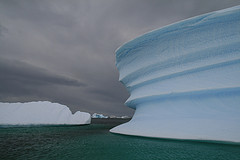 After breakfast, the day’s second excursion was another great highlight: a zodiac cruise through Iceberg Alley, a spectacular section of water dotted with hundreds of icebergs – small and big, sharp and curved, some with tunnels, others with brilliant shades of blue. We also saw an ice sheet with 14 crab-eater seals on it, which we were told was a significant number to see in one place. If we had the same weather as the day before, this trip could have been almost as magnificent as Paradise Bay (no easy feat). In any case, the dark grey clouds overhead added another colour to the Antarctic spectrum and it was still a fabulous cruise.
After breakfast, the day’s second excursion was another great highlight: a zodiac cruise through Iceberg Alley, a spectacular section of water dotted with hundreds of icebergs – small and big, sharp and curved, some with tunnels, others with brilliant shades of blue. We also saw an ice sheet with 14 crab-eater seals on it, which we were told was a significant number to see in one place. If we had the same weather as the day before, this trip could have been almost as magnificent as Paradise Bay (no easy feat). In any case, the dark grey clouds overhead added another colour to the Antarctic spectrum and it was still a fabulous cruise.
Our afternoon landing at Dorian Bay was postponed because of the weather, but we were able to do it after dinner (soup, salad, roasted lamb with vegetables, sundae) as a night landing at 9pm (‘night’ being a relative term in Antarctica in December, when it is never actually dark). But since it was pretty cold and there wasn’t any wildlife, it wasn’t an especially memorable landing.
Day 7: Neumayer Channel and Around
 Our morning landing at Cuverville Island was probably my second favourite landing of the trip after Neko Harbour. There are 5000 pairs of Gentoo penguins on the island, the most we saw in one place on the entire trip, and even after many, many penguin sightings in the past few days it was still impressive to see so many of them. The setting was beautiful too, with icebergs and glaciers very close to the landing spot. On our way back to the ship, we took a small zodiac cruise through the icebergs and we saw, relaxing on the icebergs, two pairs of mating leopard seals, which eat penguins and generally look a bit snake-like and scary. I took probably my best wildlife photo of the trip of one of them yawning with its mouth wide open and icebergs and mountains serving as the backdrop.
Our morning landing at Cuverville Island was probably my second favourite landing of the trip after Neko Harbour. There are 5000 pairs of Gentoo penguins on the island, the most we saw in one place on the entire trip, and even after many, many penguin sightings in the past few days it was still impressive to see so many of them. The setting was beautiful too, with icebergs and glaciers very close to the landing spot. On our way back to the ship, we took a small zodiac cruise through the icebergs and we saw, relaxing on the icebergs, two pairs of mating leopard seals, which eat penguins and generally look a bit snake-like and scary. I took probably my best wildlife photo of the trip of one of them yawning with its mouth wide open and icebergs and mountains serving as the backdrop.
 In the afternoon we finally saw baby Gentoo penguins at very close range at Port Lockroy and Jougla Point, which was fantastic and vindicating as that was one of the reasons we wanted to come to Antarctica later rather than sooner. The babies were still brooding, but every now and then we got a glimpse of one feeding or poking out from under their parents’ bellies. Since Gentoo penguins lay two eggs, we saw two babies under the same mother a couple of times and saw one baby with the other egg still unhatched another time (which means the first baby was no more than one day old). As part of the same landing, we also visited a British outpost at Port Lockroy, which was once a survey station and is now a museum and shop.
In the afternoon we finally saw baby Gentoo penguins at very close range at Port Lockroy and Jougla Point, which was fantastic and vindicating as that was one of the reasons we wanted to come to Antarctica later rather than sooner. The babies were still brooding, but every now and then we got a glimpse of one feeding or poking out from under their parents’ bellies. Since Gentoo penguins lay two eggs, we saw two babies under the same mother a couple of times and saw one baby with the other egg still unhatched another time (which means the first baby was no more than one day old). As part of the same landing, we also visited a British outpost at Port Lockroy, which was once a survey station and is now a museum and shop.
These were our last landings about the Antarctic Peninsula. After dinner we headed back through the Bransfield Straits to the South Shetland Islands, where we would spend our final activity day before returning to Ushuaia.
Day 8: Deception Island
At 7:30am, we reached Deception Island, a remarkable volcanic island among the otherwise Antarctic-looking South Shetland Islands. It’s a circular island with a narrow entry, Neptune’s Bellows, which we passed through to ‘enter’ the crater. After days of seeing virtually nothing but white, to see black volcanic sand, dark red rocks and the other bizarre aspects of Deception Island was quite extraordinary. However, our proposed landing at Whalers’ Bay was postponed, and ultimately cancelled, due to 30 knot winds with gusts of 35-40 knots.
That left us with only one landing left, at the Aitcho Islands in the South Shetlands. The wind was not as fierce there but it was still a cold landing in dull conditions. It wasn’t the best of landings, but we did see an elephant seal for the first time (our fourth different seal species of the trip), though it was too young to have acquired the elephant-like features that give it its name. And since we knew that this was our last landing, we soaked it up as much as we could, admired the Gentoo and Chin-Strap penguins and reminisced about everything we’d done and seen in the last four or five days.
After dinner (chicken schnitzel and salad/soup/dessert that I’ve forgotten) we headed into the dreaded Drake Passage for the long journey back to the Tierra del Fuego.
Days 9-11: ‘Lake Drake’, the Beagle Channel and Ushuaia
The journey back through the Drake Passage is always supposed to be rougher than on the way down, but somehow it was even calmer for us than it had been the first time. The staff were calling it ‘Lake Drake’ and saying that it was one of the best voyages through the Drake they could remember in years (though do they say that to every group?). Without the anticipation of an impending arrival in Antarctica, the trip back was actually pretty boring and we spent most of it reading and eating.
On Day 10, it became apparent that we were going to arrive in Ushuaia about 15 hours ahead of schedule, so we anchored in the Beagle Channel and had a celebratory BBQ and glass of champagne in the evening. After breakfast on Day 11 this morning, it was suddenly all over, but we will remember it forever as the best trip we’ve ever taken.
